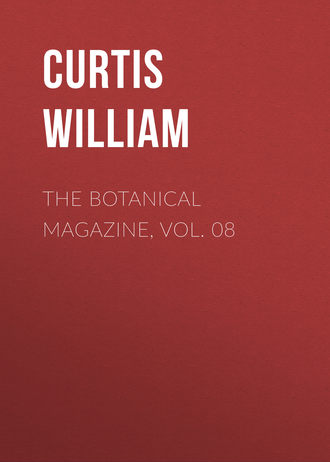 полная версия
полная версияThe Botanical Magazine, Vol. 08
It flowers from June to August, and in favourable seasons ripens its seeds, by which the plant is usually propagated.
[275]
Liriodendron Tulipifera. Common Tulip-Tree
Class and OrderPolyandria PolygyniaGeneric CharacterCal. 3-phyllus. Petala 6. Sem. imbricata in strobilum.
Specific Character and SynonymsLIRIODENDRON Tulipifera foliis lobatis. Linn. Syst. Veg. ed. 14. Murr. p. 507. Ait. Kew. v. 2. 250.
TULIPIFERA virginiana, tripartito aceris folio: media lacinia velut abscissa. Pluk. Alm. 379. t. 117. f. 5. & t. 248. f. 7. Catesb. Carol. 1. p. 48. t. 48.
LIRIODENDRON foliis angulatis truncatis. Trew. Ehret. t. x.
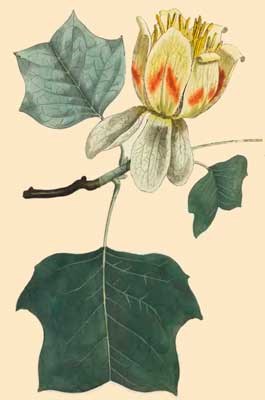
No275.
The Tulip-tree is a native of most parts of North-America, Marshall describes it as often growing to the size of a very large tree, 70 or 80 feet in height, and above 4 feet in diameter; he mentions two varieties, one with yellow and the other with white wood; that with yellow wood is soft and brittle, much used for boards, heels of shoes, also turned into bowls, trenchers, &c. the white is heavy, tough, and hard, and is sawed into joists, boards, &c. for building.
Ray informs us in his Hist. Pl. that this tree was cultivated here by Bishop Compton, in 1688: and from Miller we learn, that the first tree of the kind which flowered in this country, was in the gardens of the Earl of Peterborough, at Parsons-Green, near Fulham; in Mr. Ord's garden, at Walham-Green, there is, among other choice old trees, a very fine tulip-tree, which is every year covered with blossoms, and which afforded us the specimen here figured. It flowers in June and July, rarely ripens its seeds with us, though it does readily in America.
The foliage of this plant is extremely singular, most of the leaves appearing as if truncated, or cut off at the extremity; they vary greatly in the division of their lobes, the flowers differ from those of the tulip in having a calyx, but agree as to the number of petals, which is six; and so they are described in the sixth edition of the Gen. Pl. of Linn. but in Professor Murray's Syst. Veg. Ait. H. K. Linn. Syst. Nat. ed. 13, by Gmelin, 9 are given, this in the first instance must be a mere typographical error arising from the inversion of the 6.
This tree is found to flourish most in a soil moderately stiff and moist, is usually raised from seeds, the process of which is amply described by Miller in his Dictionary.
[276]
Blitum Virgatum. Strawberry Blite
Class and OrderMonandria DigyniaGeneric CharacterCol. 3-fidus. Petala O. Sem. 1. calyce baccato.
Specific Character and SynonymsBLITUM virgatum capitellis sparsis lateralibus. Linn. Syst. Vegetab. ed. 14. Murr. p. 53. Ait. Kew. v. 1. p. 7.
ATRIPLEX sylvestris mori fructu. Bauh. Pin. p. 519.
ATRIPLEX sylvestris baccifera. Clus. Hist. cxxxv.
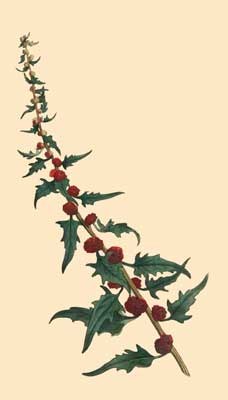
No276.
This plant, not unfrequently met with in gardens, is known to most cultivators by the name of Strawberry Spinach; the leaves somewhat resembling those of the latter, and the fruit that of the former: C. Bauhine likens its berries to those of the Mulberry, to which they certainly bear a greater resemblance: in most of the species of this genus the calyx exhibits a very singular phenomenon, when the flowering is over, it increases in size, becomes fleshy, and finally pulpy, containing the ripe seed, which however it does not wholly envelope; thus from each cluster of flowers growing in the alæ of the leaves are produced so many berries, of a charming red colour, to which the plant owes its beauty altogether, for the flowers are small, herbaceous, and not distinctly visible to the naked eye; they can boast however of being of the first class in the Linnean system Monandria, to which few belong.
Strawberry Blite is a hardy annual, growing spontaneously in some parts of France, Spain, and Tartary; is not a very old inhabitant of our gardens, Mr. Aiton mentioning it as being first cultivated by Mr. Miller in 1759. Its berries are produced from June to September; in their taste they have nothing to recommend them, though not pleasant they are harmless.
Clusius we believe to be the first author who gives a figure and description of it.
It affects a dry soil, and open situation; in such there is no necessity to give any particular directions for its cultivation, as it comes up readily from seed spontaneously scattered, so much so as sometimes to prove a troublesome weed.
[277]
Mahernia Pinnata. Winged Mahernia
Class and OrderPentandria PentagyniaGeneric CharacterCal. 5-dentatus. Petala 5. Nectaria 5 obcordata, filamentis supposita. Caps. 5-locularis.
Specific Character and SynonymsMAHERNIA pinnata, foliis tripartito pinnatifidis. Linn. Syst. Vegetab. ed. 14. Murr. p. 308. Ait. Kew. v. 1. p. 398.
HERMANNIA foliis tripartitis, media pinnatifida. Linn. Sp. Pl. ed. 3. p. 943.
HERMANNIA frutescens, folio multifido tenui, caule rubro. Boerh. Lugd. 1. p. 273.
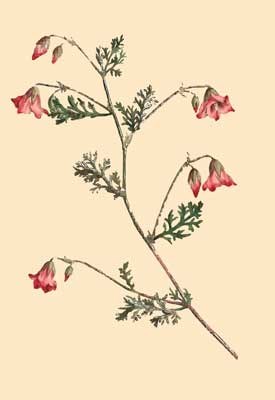
No277.
Linnæus, in his Spec. Pl. regarded this plant as a species of Hermannia; finding afterwards that it differed materially in its fructification from that genus, he made a new one of it in his Mantissa, by the name of Mahernia; still, however, the two genera are very nearly related: one principal difference consists in the nectaria of the Mahernia, which are very remarkable.
This species was introduced from the Cape, where it is a native, by Mr. Masson, in 1774, and is now very generally met with in our green-houses. It produces its little bells, of a lively red when they first open, from June to August, or September; is a small delicate plant, and easily raised from cuttings.
[278]
Lilium Candidum. White Lily
Class and OrderHexandria MonogyniaGeneric CharacterCor. 6-petala, campanulata: linea longitudinali nectarifera. Caps. valvulis pilo cancellato connexis.
Specific Character and SynonymsLILIUM candidum foliis sparsis, corollis campanulatis, intus glabris. Linn. Sp. Pl. ed. 3. p. 433. Syst. Vegetab. ed. 14. Murr. p. 324. Ait. Kew. v. 1. p. 429.
LILIUM album flore erecto et vulgare. Bauh. Pin. 76.
LILIUM album vulgare. The ordinary White Lily. Park. Parad. p. 39. t. 37. f. 4.

No278.
We may rank the White Lily among the very oldest inhabitants of the flower-garden; in the time of Gerard it was very generally cultivated, and doubtless at a much earlier period; a plant of such stateliness, so shewy, so fragrant, and at the same time so much disposed to increase, would of course soon be found very generally in gardens, into which its introduction would be accelerated on another account; it was regarded as a plant of great efficacy; among other extraordinary powers attributed to it, we are gravely told that it taketh away the wrinkles of the face.
Linnæus makes it a native of Palestine and Syria; Mr. Aiton of the Levant.
Its blossoms, which open early in July, continue about three weeks, and when they go off leave the flower-garden greatly thinned of its inhabitants.
Of the White Lily there are three principal varieties:
1. With double flowers.
2. With flowers blotched with purple.
3. With striped leaves, or leaves edged with yellow.
The two first of these are to be esteemed merely as curiosities; in the third the plant acquires an accession of beauty which it has not originally; though many persons object to variegated leaves, as conveying an idea of fickliness, that complaint cannot be urged against the foliage of the striped Lily, to which the borders of the flower-garden are indebted for one of their chief ornaments during the autumnal and winter months; early in September these begin to emerge, and towards spring another set rises up in their centre, of more upright growth, and which announce the rising of the flowering stem.
Besides these varieties, Linnæus has considered the Lilium album floribus dependentibus s. peregrinum of C. Bauhine, the Sultan Zambach of Clusius, and the Hortus Eystettensis, as one of its varieties also: Miller regards this plant as a distinct species, and those who have attentively examined the figures and descriptions of Clusius and the Hort. Eyst. will be of the same opinion.
The Lily increases most abundantly by offsets, hence it becomes necessary that the bulbs should be taken up, and reduced every second or third year; but the striped leaved variety increasing much more slowly, should remain unmolested for a greater length of time.
There is scarcely a soil or situation in which the Lily will not grow, it will thrive most in a soil moderately stiff and moist; though a native of a warm climate no severity of weather affects it with us: we may learn from this, not to regulate the culture of plants invariably by the climate in which they grow spontaneously.
The best time for removing the bulbs of this plant is about the middle of August, before they shoot forth their leaves; but they may be transplanted any time from September to spring.
[279]
Plumeria Rubra. Red Plumeria
Class and OrderPentandria MonogyniaGeneric CharacterContorta. Folliculi 2. reflexi. Semina membranæ propriæ inserta.
Specific Character and SynonymsPLUMERIA rubra foliis ovato-oblongis, petiolis biglandulosis. Linn. Syst. Vegetab. ed. 14. Murr. p. 254. Ait. Kew. v. 1. p. 298.
PLUMERIA flore roseo odoratissimo. Tourn. Inst. 659. Trew. Ehret. Tab. xli.

No279.
Plumeria is a genus of plants named by Tournefort in honour of his countryman the celebrated Plumier, it comes near to Nerium or Oleander, and contains several species, all natives of warm climates.
The present plant is a native of Jamaica, where it is known by the name of Red Jasmine, from whence seeds and large cuttings are often sent to this country; here they require the stove to bring them to flower: seed-vessels they are never known to produce.
The flowers, which are very odoriferous, are produced in July and August in large bunches, on the summits of the branches, from whence the leaves also proceed; the stems, which grow to a considerable height as well as thickness, are naked, and the whole plant loses its foliage from the middle of winter till about the beginning of May; the branches and other parts of the plant, when broken off, give forth a milky juice, the leaves are handsome, and the veins remarkable.
Being too tender to bear the open air of this climate, it is kept in the stove even during summer, in hot weather it must have plenty of air, and in cold seasons be sparingly watered.
Is propagated by seeds, but more frequently by cuttings, which Miller recommends to be put by for two months or ten weeks, previous to their being committed to the earth.
[280]
Apocynum Androsæmifolium. Tutsan-Leav'd, or Fly-Catching Dogsbane
Class and OrderPentandria DigyniaGeneric CharacterCor. campanulata. Glandulæ 5 cum staminibus alternæ.
Specific Character and SynonymsAPOCYNUM androsæmifolium caule rectiuseulo herbaceo, foliis ovatis utrinque glabris, cymis terminalibus. Linn. Syst. Vegetab. ed. 14. Murr. p. 258. Ait. Kew. v. 1. p. 303.
APOCYNUM canadense; foliis androsæmi majoris. Bocc. sicc. 35. t. 16. f. 3. Moris. Hist. 3. p. 609. s. 15. t. 3. f. 16.
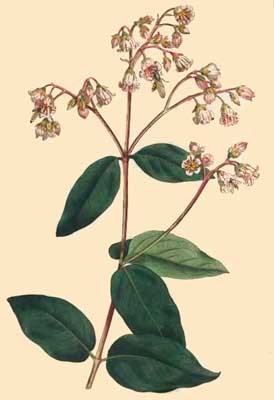
No280.
In addition to the powerful recommendations of beauty and fragrance, the Tutsan-leav'd Dogsbane interests us on account of the curious structure of its flowers, and their singular property of catching flies.
This species is a native of different parts of North-America; Mr. W. Hale, of Alton, Hants, who resided at Halifax in Nova-Scotia several years, brought me some seeds of it gathered in that neighbourhood, which vegetated, and produced flowering plants: it is not new to this country, being known to Morison who figures it, and to Miller, who cultivated it in 1731.
It is a hardy perennial plant, growing to about the height of a foot and a half, or two feet, and flowering from the beginning of July, to September; it has a creeping root, thereby it increases greatly in light dry soils, and warm situations, so as even to be troublesome; it will not thrive in a wet soil; with us it produces seed-vessels but rarely; is propagated by parting its roots in Autumn or Spring; Miller recommends March as the most proper season, or it may be raised from seeds, which in certain situations and seasons ripen here.
The flowers of this Apocynum have a sweet honey-like fragrance, which perfumes the air to a considerable distance, and no doubt operates powerfully in attracting insects; when a plant of this sort is fully blown, one may always find flies caught in its blossoms, usually by the trunk, very rarely by the leg; sometimes four, or even five, which is the greatest possible number, are found in one flower, some dead, others endeavouring to disentangle themselves, in which they are now and then so fortunate as to succeed; these flies are of different species, the musca pipiens, a slender variegated fly with thick thighs, is a very common victim, the musca domestica, or house fly, we have never observed among the captives.
Previous to our explaining the manner in which it appears to us that these insects are caught, it will be necessary that we should describe, in as plain a manner as possible, those parts of the flower which more particularly constitute this fatal fly trap.
On looking into the flower we perceive five Stamina, the Antheræ of which are large, of a yellow colour, and converge into a kind of cone; each of these Antheræ is arrow-shaped, towards the top of the cone their sides touch but do not adhere, below they separate a little, so as to leave a very narrow opening or slit between each, they are placed on very short filaments, which stand so far apart that a considerable opening is left between them, which openings, however, are closed up by processes of the corolla, nicely adapted to, and projecting into them; at the bottom of, and in the very centre of the flower, we perceive two germina, or seed-buds, the rudiments of future seed-vessels, surrounded by glandular substances, secreting a sweet liquid; on the summit of these germina, and betwixt the two, stands the stigma, in the form of a little urn, the middle of which is encircled by a glandular ring, which secretes a viscid honey-like substance, to this part of the stigma the Antheræ interiorly adhere most tenaciously, so as to prevent their separation unless considerable force be applied; it is, as we apprehend, the sweet viscid substance thus secreted by the stigma, within the Antheræ, which the fly endeavours to obtain, and to this end insinuates its trunk first into the lowermost and widest part of the slit, betwixt each of the Antheræ above described, pushing it of necessity upwards: when gratified, not having the sense to place itself in the same position as that in which it stood when it inserted its trunk, and to draw it out in the same direction downwards, unfortunately for it, it varies its position, and pulling its trunk upwards, draws it into the narrow part of the slit, where it becomes closely wedged in, and the more it pulls the more securely it is caught, and thus this heedless insect, as Thomson calls it, terminates its existence in captivity most miserable.
In the incomparable poem of Dr. Darwin, entitled the Botanic Garden, there is a figure given of this plant; and in the Supplement we have the following account written by Mr. Darwin, of Elston.
"In the Apocynum Androsæmifolium the Anthers converge over the nectaries, which consist of five glandular oval corpuscles, surrounding the germ, and at the same time admit air to the nectaries at the interstice between each anther; but when a fly inserts its proboscis between these anthers to plunder the honey, they converge closer, and with such violence as to detain the fly, which thus generally perishes."
This explanation of a phænomenon entitled to much attention, is widely different from ours; which of the two is most consonant to truth and nature, we shall leave to the determination of future observers.
In explaining the preceding appearances, to prevent confusion we called those parts which form the cone in the middle of the flower Antheræ, but strictly speaking they are not such, the true Antheræ being situated on the inside of their summits, where they will be found to be ten in number, making in fact the Apocynum a decandrous plant.
[281]
Turnera Angustifolia. Narrow-Leav'd Turnera
Class and OrderPentandria TrigyniaGeneric CharacterCal. 5-fidus, infundibuliformis, exterior 2-phyllus. Petala 5 calyci inserta. Stigmata multifida. Caps. 1-locularis, 3-valvis.
Specific Character and SynonymsTURNERA angustifolia floribus sessilibus petiolaribus, foliis lanceolatis rugosis acuminatis. Mill. Dict. ed. 6. 4to.
TURNERA frutescens folio longiore et mucronato. Mart. Cent. 49. t. 49.
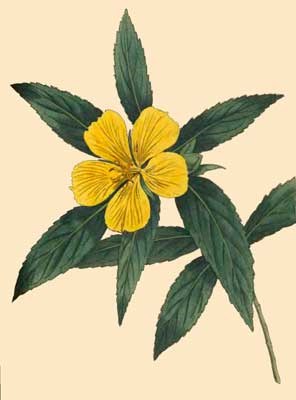
No281.
This plant here represented is generally known to the Nurserymen about London as the Turnera ulmifolia, or Elm-leav'd Turnera, its foliage however does not answer to the name, nor to the figures of the plant as given by Martyn in his Cent. Pl. and Linnæus in his Hortus Cliffortianus, which figures indeed are so similar that they look like copies of each other, these represent the true elm leaf; on the same plate of Martyn's Cent. there is given a very excellent figure of what he considers as another species of Turnera, vide Synon. and which Miller, who cultivated it about the year 1773, also describes as a distinct species, under the name of angustifolia, asserting, from the experience of thirty years, that plants raised from its seeds have constantly differed from those of the ulmifolia; this is our plant, which on his authority we have given as a species, though Linnæus regards it as a variety.
Plumier gave to this genus the name of Turnera, in honour of Dr. William Turner, a celebrated English Botanist and Physician, who published an Herbal, black letter, folio, in 1568.
The present species is a native of the West-Indies, and is commonly cultivated in our stoves, where it rises with a semi-shrubby stalk, to the height of several feet, seldom continuing more than two or three years; young plants generally come up in plenty from seeds spontaneously scattered, so that a succession is easily obtained.
It flowers from June to August.
Its foliage has a disagreeable smell when bruised; its flowers are shewy, but of short duration, and are remarkable for growing out of the footstalk of the leaf.
[282]
Hedysarum Obscurum. Creeping-Rooted Hedysarum
Class and OrderDiadelphia DecandriaGeneric CharacterCor. carina transverse obtusa. Legumen articulis 1-spermis.
Specific Character and SynonymsHEDYSARUM obscurum foliis pinnatis, stipulis vaginalibus, caule erecto flexuoso, floribus pendulis. Linn. Syst. Vegetab. ed. 14. Murr. p. 676. Mant. 447. Jacq. Fl. Austr. v. 2. t. 168.
HEDYSARUM caule recto, ramoso; foliis ovatis; siliquis pendulis, lævissimis, venosis. Hall. Hist. Helv. n. 395.
ONOBRYCHIS semine clypeato lævi. Bauh. Pin. 350.
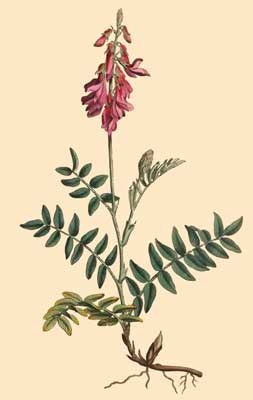
No282.
Prof. Jacquin, in the second volume of the Flora austriaca, gives an excellent figure and accurate description of our plant, a native of the Alps of Germany and Switzerland, and points out the characters in which it differs from the alpinum, for which it has sometimes been mistaken.
It is a hardy perennial, rarely exceeding a foot in height, produces its spikes of pendulous flowers, which are of a most beautiful purple colour, in July and August; hitherto these have not been succeeded by seed-vessels with us; though we have cultivated the plant for several years.
Its size renders it a suitable plant for rock-work, on which it will grow readily, increasing by its roots, which are of the creeping kind.
Haller mentions a variety of it with white flowers.
[283]
Mimulus Ringens. Narrow-Leaved Monkey-Flower
Class and OrderDidynamia AngiospermiaGeneric CharacterCal. 4-dentatus, prismaticus. Cor. ringens; labio superiore lateribus replicato. Caps. 2-locularis, polysperma.
Specific Character and SynonymsMIMULUS ringens erectus, foliis oblongis linearibus sessilibus. Linn. Syst. Vegetab. ed. 14. Murr. p. 575. Ait. Kew. v. 2. p. 361.
EUPHRASIA floridana lysimachiæ glabræ siliquosæ foliis, quadrato caule ramosior. Pluk. Amalth. 83. t. 393. f. 3.
LYSIMACHIA galericulata s. Gratiola elatior non ramosa, &c. Gron. Fl. Virg. p. 97.
DIGITALIS perfoliata glabra flore violaceo minore. Moris. Hist. 2. p. 479. s. 5. t. 8. f. 6.
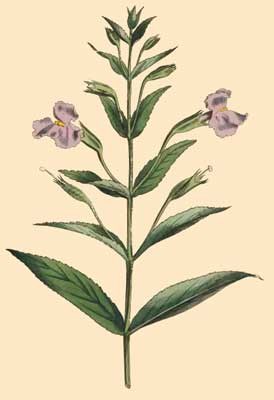
No283.
Clayton, in the Fl. Virg. published by Gronovius, describes this plant as a native of Virginia, and says of it, "maddidis gaudet locis," it delights in wet places: Linnæus makes it a native of Canada also.
It is a hardy, perennial, herbaceous plant, growing with us to the height of about two feet, and producing its flowers, which are of a pale violet colour, in July and August; these are frequently succeeded by capsules containing perfect seeds, by which the plant may be propagated, as also by parting its roots in Autumn; Miller recommends the seeds to be sown as soon as ripe.
The plant succeeds best in a moist and somewhat shady situation, with a loamy soil.
A perusal of the synonyms will shew to what a variety of genera this plant has been referred by different authors; Linnæus first gave to it the name of Mimulus, of which term we find in his Philosophia Botanica the following concise explanation:—"Mimulus mimus personatus;" in plain English, a masked mimick: Mimmulus is a classical word for the Pedicularis, or Lousewort; the English term Monkey flower has probably been given it, from an idea that mimulus originated from μιμω a monkey, as in mimusops monkey face.
[284]
Rosa Semperflorens. Ever-Blowing Rose
Class and OrderIcosandria PolygyniaGeneric CharacterPetala 5. Cal. urceolatus, 5-fidus, carnosus, collo coarctatus, demum baccatus, coloratus. Antrum duplicatum, 1-loculare, superne apertum, pericarpiis osseis intus nidulantibus.
Specific CharacterROSA semperflorens caule aculeato, foliis subternis, pedunculis subunifloris aculeato-hispidis, calycis laciniis integris.

No284.




